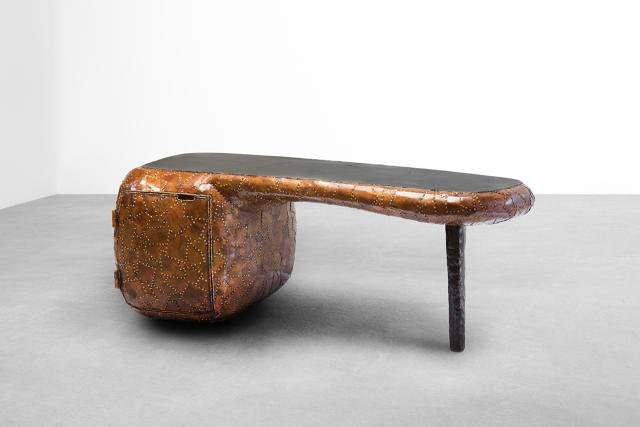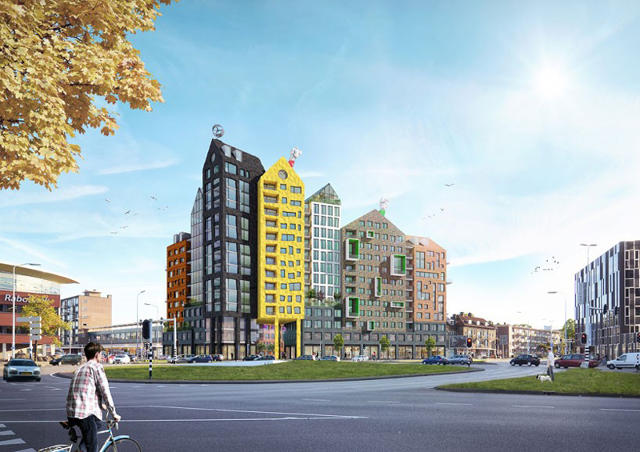What do you do when you've made your creative statement? When there's no "next thing" to move onto? Maarten Baas, the Dutch designer and Renaissance man who earned his star bridging the divide between art and design, faced such a dilemma recently. He'd enjoyed a meteoric rise after graduating from the prestigious Design Academy Eindhoven in 2002, aided by the attention of gallerists such as Murray Moss, tastemakers such as Li Edelkoort, and the then-nascent fame machine called the Internet. But he grew disillusioned by what he saw as a broken system: wasteful products flooding the market and an unhelpful audience that dissected his every move. So he turned his back on the design world (at least the public-facing part) and focused on private commissions that let him explore his own ideas and, as he says, go "where I want to go." Now he's back with architectural-scale work and Carapace, a new gallery show that includes case goods, chairs, and a desk made from a patchwork of spot-welded bronze and steel. We caught up with him recently in New York.
FAST COMPANY: What's the concept behind "Carapace"?

MAARTEN BAAS:"It's kind of like armor or a shield. The title of the show is called Carapace, which means the shell of a turtle or a beetle—an [exoskeleton] in which something fragile hides. It's a really strong skin that protects it from outside influences, which kind of symbolizes how I've felt in the last few years. During the first years of my work, I did a lot and I presented all over the world. Then I went back to my studio in order not to be influenced by all the things that come from outside. So this reflects that time.

"Carapace was very much a collaboration with Carpenters Workshop Gallery. They really pushed it to the next level in terms of functionality and the looks and that every detail should be worked on. It's a very luxurious position to be put in, as a designer, to really have the opportunity to make pieces in which so many labor hours can be invested. I actually stopped counting [how long it took to develop the furniture] at a certain point. We went just full on with the whole studio. Now when we redo it, it would still take one man a few weeks to work on it. It's a lot of hours to develop it, to perform the tests, to fail the tests, and to try it again. The whole thing is a back and forth of trial and error. But that's why we make those exclusive pieces. You want to make something that has never been done before. You have to invent a wheel."
What sparked your decision to sort of remove yourself from outside influences?
"There were a lot of things coming together around 2010 and 2011, a few personal things and also career-wise. I won designer of the year award [from Design Miami], and there were a lot of other things I accomplished. Creatively, I felt like I kind of made my statement. There wasn't a 'next thing' to move onto. I got kind of crazy about how everything was looked at by thousands of people who all had an opinion on whatever I did. I thought, what the fuck man? I just want to explore myself and where I want to go. So I still did things, but they were under-the-radar private commissions, which never have been publicized. I didn't want to put something out there that is then [interpreted as] a statement or that people needed to have an opinion about."
That the design discussion has become much more accessible through the web is something that we've been talking about—there's also a lot of noise to sift though. So you felt like you needed to regroup and find the next step in your creative trajectory?
"Yeah, that's exactly it. In the meantime, I was working on pieces—and these pieces in the show—but nobody knew about them until today. I've been in the middle of [the design discussion] since right after my graduation [in 2002]. I had been jumping around for a few years and said it was time to take a step back."
You mentioned that spending so much time on research and development is somewhat of a luxury today. There's pressure to move so quickly in design. What impact do you think that has on the industry at large?
"I want to make pieces that last forever. When you buy one piece you're happy with it and proud of it and want to keep it for the rest of your life. That's my target. In a way, it's a response to the disposable shit that we make normally. The [Carapace pieces] are made to be timeless. I think that by putting so many man-hours into the furniture gives it personality. You feel connected with the piece in a different way than if it was just from an anonymous factory, made by an anonymous employee. The actual dollar value of the piece is high, but so is the emotional value—you can be proud of it."

So now you're back in the thick of the design world and expanding into architecture with a mixed-use building in Eindhoven. Can you tell me a bit about your desire to move into a much larger scale and explore that side of your work?
"I just like to explore anything that comes along my path. I don't restrict myself to a certain style or have a no-go area of design. Within the same month, I had to finish the architecture project and do a cutlery set, so that kind of gives an example of my entire scope. I like to see what I can do, what value I can add to the world. Since I was invited to participate in that architectural project, I thought let's do it in my way and see what happens. The only thing, though, is that I am rather impatient normally. With architecture, you have to have patience and be diplomatic because there are a lot of parties involved who all have their reasons to do or not to do certain things. I have to be very diplomatic, which is not my strongest suit."
Nowadays a lot of the more experimental buildings are very heavily scrutinized, and there's always the question of pragmatics versus doing something adventurous. How do you feel about the way architecture is discussed today, and what did you want your contribution to the discussion to be?
"I think with a lot of my work I try to achieve an instant feeling. Before you can think about why you feel affected by it, it's already inside of you. For example, my Clay furniture is intuitively made, and intuitively you feel like, yeah, I want this or I like this, even though there are rational reasons why you'd say, that's not how you should design, or that's not how [furniture should be]. I like to go around that difficulty.
"I think that the idea of something being rationally good is still very much in architecture, that you can justify why you think this building is accepted and good, but then you step over the most important thing: Do I like it in the end? Is the world better because this building is there? If an architect designs a drinking glass, then he would make it in such a way that it is a 'good design.' And somebody else, me for instance, would design a glass that's whatever. If a random person comes and says, 'No, I like your glass,' the architect would say, 'No, no, don't like that one. I will explain why [mine] is better.' That's the difference I saw in architecture and what could I add to architecture."

What excites you most about design today?
"I'm very much in my own world, and I like very much that design opens up more and more in different areas. I see design as a platform to play around in all disciplines of creativity. I think that notion is more and more accepted, that we don't necessarily put design in categories. Whatever you call it, if it's good, then it's good. There was a long time in which people tried to pinpoint what they were looking at before they could have a feeling or an opinion about it. Now there's consensus from everybody that in the world of design that you can expect anything—just be open to it, whatever it is. Is it a theater performance? Is it food design? Is it a piece of furniture? Is it a sculptural piece? It is there, and like it or not, but that's it."
So these gray areas and hybrids are opening the doors for creative expression.
"Yeah, and I like that very much. I jump from architecture to cutlery to theater to my clocks, which are more like films. I like to kind of explore all those little areas and create my own platforms. It seems that it's more and more accepted [to do that]."
Is there something that's especially worrisome or concerning to you about the state of design?
"I never really worry that much about things. Of course there are things that are going wrong, but then probably they are supposed to go wrong and they'll solve themselves, and we'll find other ways to go on. If you ask, 'Am I concerned about something?' then it feels like I don't want it to happen, or I'm afraid something terrible is going to happen. I see a lot of things going wrong, but I say, let's just make other things in the meantime.
"There's a lot of mass production: a trendy thing today that you throw away tomorrow. That's not typically what I like or what I stand for. Often I see the label of 'green design' put on many things whereas the greenest thing you can do is not to design at all. So why find an excuse to make a thing that's not needed out of a recycled material? What's the point?"
All Images (unless otherwise noted): Courtesy of Carpenters Workshop Gallery